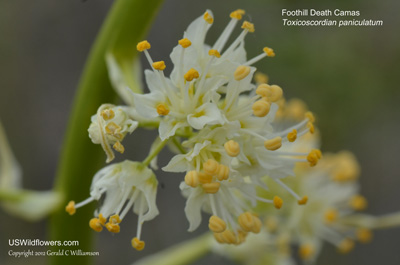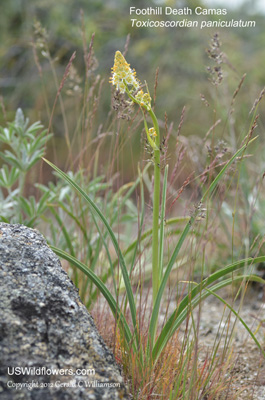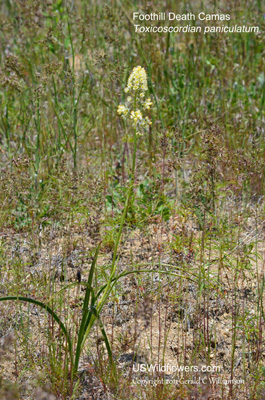Wildflowers of the United States | |||||||||||||||||||||||||||||||||||||
| |||||||||||||||||||||||||||||||||||||
Toxicoscordion paniculatum - Foothill Death Camas, Foothills Deathcamas, Panicled Death Camas, Sand-corn. Synonym: Zigadenus paniculatus - a name still used by some authorities. In addition to reclassification out of the Zigadenus genus, it has recently been moved out of Liliaceae and into the Melanthiaceae family. Only a single U.S. plant remains in the Zigadenus genus (Z. glaberrimus - Sandbog Death Camas.) Interestingly, Trillium has also been moved out of Liliaceae and into the Melanthiaceae. I would not have guessed the close relationship between Trillium and other Melanthiaceae species.
Toxicoscordion paniculatum is a plant of the western United States, found in dry sagebrush scrub and conifer forests at moderately high elevations - from about 3,000 feet up to 7,000 feet. Due to the rarity of the plant in Arizona, collecting the plant is restricted in that state.
| Similar species: Toxicoscordion venenosum, which is a somewhat smaller species, and the inflorescence is a raceme rather than a panicle, although there might be a single branch at the bottom of the inflorescence. My photos of this plant, however, show several branches, indicating a panicle, although the upper half of the inflorescence is racemose. T. venenosum prefers moister soil than does T. paniculatum. Found in: AZ, CA, CO, ID, MT, NM, NV, OR, UT, WA, WY Leave comments on Toxicoscordion paniculatum at this link.   Blue=Native; Grey=Introduced Map from USDA Plants Database: USDA, NRCS. 2017. The PLANTS Database (http://plants.usda.gov, 08 May 2025). National Plant Data Team, Greensboro, NC 27401-4901 USA. Search Our Database: Enter any portion of the Scientific, Common Name, or both. Do a general Google search of the entire site: #ad
| #ad
| | ||||||||||||||||||||||||||||||||||
|
Commercial / Cookie Notice Looking for Wildflowers for a specific state? Check here: | |||||||||||||||||||||||||||||||||||||
|
| |||||||||||||||||||||||||||||||||||||




